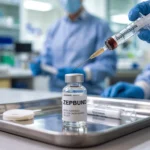Watching your child transition from childhood to adolescence is both exciting and challenging. Physical, emotional, and behavioral changes often occur so rapidly that parents might struggle to keep up. Recognizing the early signs of growth spurt can help you better support your child during this transformative stage.
Puberty consists of multiple different phases, the most notable of which is the growth spurt phase, which is characterized by rapid gain of height and weight. The body is getting ready to become an adult. Rapid physical changes are accompanied by emotional changes. This can alter moods, affect appetite, and change self-esteem.
Understanding these signs helps parents give the appropriate support, guidance, and patience that a teen needs during a time that may feel unorganized. Here are the most dominant signs that help identify growth spurts and the appropriate ways to assist your child.
Physical Development and the First Signs of Growth Spurt
A visible physical change is one of the most common signs of a growth spurt. A child might be nearing the age of the growth spurt, and it may seem like they have shot up overnight, with pants that become too short and shoes that are quickly outgrown. Height increase is the most notable indicator of a growth spurt, but this is only one piece of the puzzle.
The arms and legs begin to stretch out and grow longer than the torso for a while. The changes in the body and the clumsiness that goes with the changes in the body can make posture and coordination seem out of sync for a brief time.
A common physical change accompanied by a growth spurt is a sudden increase in appetite that can seem insatiable. The body is seeking high energy and fueled growth, and it results in portion sizes that seem large and cravings for high-protein foods. This is a time in a person’s life when eating is definitely not just a “phase.” It is the body’s way of saying additional energy and nutrients need to be acquired and consumed to keep it going.
Adequate and restful sleep is very important and becomes a constant during a growth spurt. More growth hormones are active during deep sleep, and really, rest should be encouraged for development. These changes and their physical shifts should be recognized for development to be seamless.
Emotional and Behavioral Changes as Signs of Growth Spurt
The physical changes of a growth spurt can be followed by the emotional changes that take place. One of the less explicit signs of a growth spurt is when irritability, mood, or behavior changes are most noticed.
This turbulence doesn’t mean anything is wrong; it is just the body adapting to internal changes. Understandably, some frustration may come from having emotions that are difficult to express, or emotions that are even difficult to understand.
Parents may observe their child exercising newfound autonomy or increased self-consciousness about their looks, which are behavioral clues that accompany the physical changes.
Encouraging open communication about anything and everything will help the teen feel supported. Changes in feelings and emotions are normal. Feeling supported will aid in fostering the balance that is so important to emotional well-being.
Sleep Patterns and Fatigue: Hidden Signs of Growth Spurt
An increase in sleepiness and fatigue, which also serves to tip off one of the hidden signs of a growth spurt, can signal that your child’s body is working overtime.
Immense energy is expended during growth, and sleep serves to restore that energy. The body releases more growth hormones, especially human growth hormone (HGH), during sleep to aid in the growth and development of muscles and bones.
Some parents might observe that their child wants to sleep more or take more naps during the day. Though it can seem that the child is just being lazy, it is a biological requirement that must be met. Encouraging rest, having proper, consistent times to sleep, and having the room remain calm and dark can aid in having more restorative sleep.
Evaluate one’s diet and fluid intake when there is chronic fatigue, regardless of having plenty of rest. This is because tiredness can be aggravated during growth periods due to a poor nutritional diet.
Appetite Increase and Nutritional Needs
A body during a growth spurt needs more calories and nutrients to sustain rapid development. An increased appetite is one of the clearest signs of a growth spurt in both boys and girls.
At times, children will snack more often or request bigger meals; it is a sign that their body needs more fuel and should not be categorized as uncontrolled eating.
Ensure meals are balanced and incorporate lean meat, whole grains, fruits, and vegetables. Foods that are high in calcium and vitamin D help the bones grow. Iron and zinc are essential for energy, immune function, and growth.
Choose energizing, balanced meals and snacks instead of highly processed food and drinks, as they cause energy dips and crashes. These will support steady growth and keep energy levels up.
Your teen also needs good nutrition so their body can adapt to the health challenges brought on during the teen years and to establish good health for the future.
Growth-Related Aches and Pains
Some older kids and teens during their growth years may have some mild aches or pain, for example, in the legs and knees, in addition to the more common growth pain, which may also signal the beginning of their signs of growth spurt phase.
These discomforts may also affect activity and sleep, but are not dangerous. Suggest some light stretching to encourage relaxation of the deeper muscles. A warm bath and gentle massage can also help.
Muscle soreness can also be relieved by drinking enough water and including more of either magnesium or potassium in the diet. It is always good to see a doctor if pain is severe and not going away to make sure there is nothing else going on. For the most part, aches and pain are temporary and will go away as the body adjusts to the new growth.
Changes in Coordination and Motor Skills
Sometimes, when children are going through growth spurts, the limbs grow faster than the body can adjust, and the body becomes awkward or clumsy. You may see your child trip more or have a more difficult time doing things that were easier in the past.
Temporary clumsiness and poor coordination can be frustrating, but they are completely normal parts of the adjustment phase. This is the time when the nerves and the body proportions are out of sync. Fine motor clumsiness will improve with time as the body moves to the next developmental stage.
Supporting and encouraging coordination, balance, and self-control exercises like swimming, stretching, and even yoga can ease your child’s awkwardness.
This is one of the reassuring signs of growth spurts.
Skin and Hair Changes
The body goes through hormonal changes during development, and the changes will first be seen on the skin and hair. Oily skin, hair growth in new places, and acne are all symptoms of hormonal changes.
Transformations within a person, regardless of how trivial they may seem, are indications that milestones within development are occurring. Good hygiene, including washing the face and skin routine, is the first step toward good hygiene maintenance that helps the person transition with confidence.
Positive self-concept is important and helps the person learn about themselves as well as their body. A strong self-concept helps the person attain their self-evaluative goals.
The transforming facade is the initial sign of a growth spurt, noting the advancing changes within the body and the onset of the adolescent period.
Emotional Sensitivity and Independence
Teenagers wish to have more freedom and self-rule. These changes include stronger beliefs and opinions as well as self-identity. Such changes are perfect indicators of smart emotional growth triggered by the shift.
The need to have self-identity may cause the person to clash with authority, yet it is crucial for having a well-adjusted growth shift. Noticing the emotional signs of a growth spurt helps the parent manage the situation without anger.
Self-rule is essential, but the shift must be guided by firm control and limits. Such limits help self-support and self-direction.
Academic and Cognitive Growth
Intellectual development, as well as physical development, takes place together. In certain cases, new interests are developed, complex problems are tackled, and emotional competency is enhanced.
These types of thoughts mark another fascinating aspect of growing adolescence: brain expansion. Encourage exploratory thinking and creativity along with the pursuit of academics, to help sustain these developing skills.
This period can also bring about tension, especially with schoolwork. Helping your teen transition more smoothly will mean supporting their mental well-being through things like mindfulness, open conversation, and regular breaks.
Understanding these cognitive changes as part of the signs of a growth spurt enables more effective and even-handed parenting.
Supporting Your Teen During a Growth Spurt
Addressing the signs of a growth spurt with understanding and empathy can change the outcome dramatically. Discovery defines this period of a person’s life, and as a parent, your job is to offer companionship, necessary boundaries, and unconditional support.
Help your child adopt healthy behaviors like properly balanced meals, physical activity, restorative sleep, mental well-being, and the open expression of their emotions. Participate in the celebration as they physically and personally grow, and let them know that all of this change is an exciting transition.
Most importantly, maintain your patience. Growth spurts can feel strange and come with irregularity, but they also represent a shift into adulthood. Your support and guidance will help your child.
Hillside Horizon sees how important these young years are. We aim to assist families through education, awareness, and compassion—teens in these years getting not just taller, but stronger.







